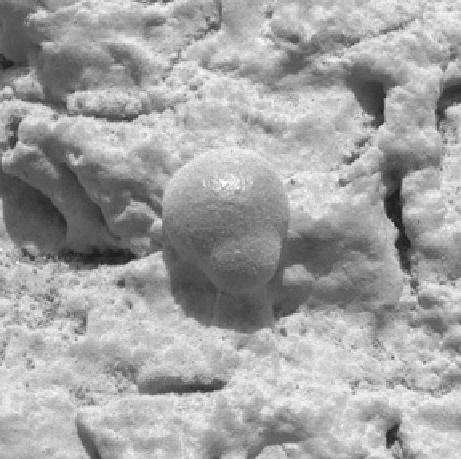Geoscience Reference
In-Depth Information
Fig. 8.16
Partly embedded
spherules. This image is
1.3 cm (half an inch) across -
NASA/JPL-Caltech/Cornell
University/USGS/Texas
A&M University, March 2,
2004)
sustained precipitation in the area around Valles Marineris. The types of minerals
there are associated with water. Also, the high density of small branching channels
indicates a great deal of precipitation.
Rocks on Mars have been found to frequently occur as layers, called strata, in
many different places. Layers form by various ways, including volcanoes, wind, or
water. Light-toned rocks on Mars have been associated with hydrated minerals like
sulfates and clay. The orbiter helped scientists determine that much of the surface of
Mars is covered by a thick smooth mantle that is thought to be a mixture of ice and
dust.
The ice mantle under the shallow subsurface is thought to result from frequent,
major climate changes. Changes in Mars' orbit and tilt cause significant changes
in the distribution of water ice from polar regions down to latitudes equivalent to
Texas. During certain climate periods, water vapor leaves polar ice and enters the
atmosphere. The water returns to the ground at lower latitudes as deposits of frost or
snow mixed generously with dust. The atmosphere of Mars contains a great deal of
fine dust particles. Water vapor condenses on the particles, and then they fall down
to the ground due to the additional weight of the water coating. When ice at the top
of the mantling layer goes back into the atmosphere, it leaves behind dust, which
insulates the remaining ice.
In 2008, research with the Shallow Radar on the Mars Reconnaissance Orbiter
provided strong evidence that the lobate debris aprons (LDA) in Hellas Planitia and
in mid- northern latitudes are glaciers that are covered with a thin layer of rocks.
Its radar also detected a strong reflection from the top and base of LDAs, meaning
that pure water ice made up the bulk of the formation. The discovery of water ice in
LDAs demonstrates that water is found at even lower latitudes.

Search WWH ::

Custom Search